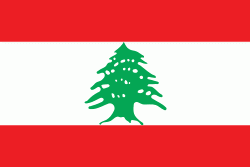Beirut Governorate (Beyrouth)
The area of this governorate is 19.8 km2 (without suburbs); despite its small size, it is considered the most important region in Lebanon because of its economic, political, cultural, and social activity. The governor of the Beirut Governate is Greek Orthodox according to tradition, while the mayor of the City of Beirut is Sunni Muslim. Beirut is known to be the most religiously diverse city in the Middle East. There are about 2.5 million people in Beirut and its suburbs (Greater Beirut).
* Beirut (Greater Beirut)
Map - Beirut Governorate (Beyrouth)
Map
Country - Lebanon
 |
 |
| Flag of Lebanon | |
The earliest evidence of civilization in Lebanon dates back to 5,000 BCE. From c. 3200–539 BC, it was home to the flourishing Phoenician civilization before being annexed by various Near Eastern empires. In 64 BC, the Roman Empire conquered the region, and the region became a major center for Christianity under the Byzantine Empire. In the 7th century, the Muslim conquest of the Levant established caliphal rule. The 11th century saw the start of the Crusades and the establishment of Crusader States in the region only for it to be later reclaimed by the Ayyubids and Mamluks before being ceded to the Ottoman Empire in the 16th century. Under Sultan Abdulmejid I, the first Lebanese protostate took form in the 19th century as the Mount Lebanon Mutasarrifate, created as a home for the Maronite Christians under the Tanzimat reforms.
Currency / Language
| ISO | Currency | Symbol | Significant figures |
|---|---|---|---|
| LBP | Lebanese pound | لل | 2 |
| ISO | Language |
|---|---|
| AR | Arabic language |
| HY | Armenian language |
| EN | English language |
| FR | French language |
















